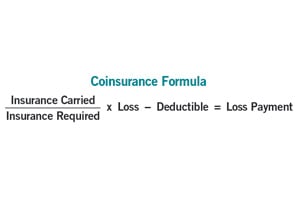Coinsurance: The Misunderstood Property Insurance Pitfall

How often should you review your property insurance policy to make sure you’re fully covered?
Most businesses carry some form of property insurance to cover significant damage or even a total loss. Coinsurance is one of the least understood areas of property insurance — and unfortunately, failing to understand it could lead to thousands of dollars in losses if catastrophe strikes.
What Is Coinsurance?
Coinsurance is an agreement between an insurance company and a business owner to share the cost of a claim. In other words, the policy holder is required to hold a high enough insurance limit to cover a percentage of the property value in order to receive full compensation if there is a loss or damage to the property.

Coinsurance functions as a percentage of the replacement cost of the insured property, such as 90 percent, 80 percent, 70 percent, etc. For example, say a company owns a building valued at $1 million and the coinsurance clause has an agreement of 90 percent. This means the property must be insured to at least 90 percent — or $900,000 — of the replacement cost.
An owner could face a big penalty if he or she decides to skimp on the insured value of the building or if the property value rises and the insurance amounts were not raised accordingly. Here is the formula for the penalty:
As an example, consider a $1 million building and a 90-percent coinsurance clause. Assume that the owner decides to insure the building at $800,000, instead of $1 million or the minimum $900,000 to meet the coinsurance. There also is a $10,000 deductible.
Now, imagine the building catches on fire and causes $300,000 worth of damage. At the time of loss, the owner’s limit was $800,000. Unfortunately, there is not enough coverage because the owner was supposed to purchase at least $900,000 in coverage according to the 90-percent agreement.
The ratio of the amount the owner carried divided by the amount that was required ($800,000/$900,000) is .889. Even though the owner’s loss was $300,000, the insurer will only pay $266,700 ($300,000 x .889) minus the $10,000 deductible, or $256,700. The owner must pay the remaining $43,300 out of pocket.
Why It’s Necessary to Review A Policy
Property owners who want to make sure they have enough coverage are strongly encouraged to review their property insurance policy regularly, because it does not automatically increase along with the value of the property. If they are not proactive about adjusting it as the value of a property increases, owners may find themselves with inadequate coverage when an accident happens.
Here are several reasons why frequently reviewing a policy is a good idea:
- The value of a property could rise above and beyond the natural increase in property values in a geographical area.
- A single office that continues to accumulate space throughout the floor and/or other parts of a building, thus increasing the value of the property.
- As construction costs for labor and material goes up, replacement costs (which a coinsurance policy is based on) will eventually exceed market value.
Waiving Coinsurance
Property owners may find it difficult to figure out if they have a coinsurance clause in their property insurance policy. But chances are, they do. In some special cases, it is even possible to get the coinsurance waived. If the property owner can have coinsurance waived and an agreed value of the property, then there is no coinsurance issue to worry about.
While insurance companies usually prefer not to waive coinsurance, it can be done.

James Eldredge is a Certified Insurance Counselor (CIC) and a construction risk insurance specialist with the Buckner Company in Salt Lake City, Utah.






